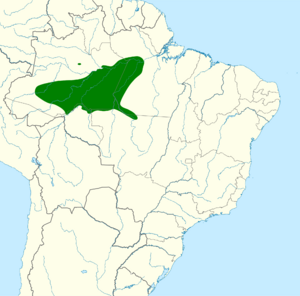Kawall's amazon facts for kids
Quick facts for kids Kawall's amazon |
|
|---|---|
 |
|
| At Rio Cristalino, Mato Grosso, Brazil | |
| Conservation status | |
| Scientific classification | |
| Genus: |
Amazona
|
| Species: |
kawalli
|
 |
|
The Kawall's Amazon (Amazona kawalli) is a special type of parrot. People also call it the white-faced amazon or Kawall's parrot. It's a fairly large bird that lives only in the south-central part of the Amazon rainforest in Brazil. For about 70 years, no one saw this parrot in the wild. But then, in the 1980s, it was found again!
Contents
Meet the Kawall's Amazon Parrot
This amazing parrot is about 35 to 36 centimeters (about 14 inches) long. That's a medium size for a parrot. Most of its feathers are a bright green color.
Here are some cool features that help you spot a Kawall's Amazon:
- It has a thin white stripe right above its beak.
- There's a small white ring around its eyes.
- Its outer flight feathers have hints of blue and red.
- It has a unique white patch of skin at the base of its beak.
- You might see some red feathers near the base of its tail.
- Its green color is often brighter than other similar parrots.
Where Does This Parrot Live?
The Kawall's Amazon lives in the Amazon Basin of Brazil. It has been seen in the states of Amazonas and Pará. Scientists think it might live in other places too, or maybe in small groups far apart. This is because one parrot was once wrongly thought to be from 'Colombia'. Also, a captive bird was found near the Amazonas National Park.
These parrots love to live in lowland rainforests. They especially like areas that are always flooded. You can often find them along the edges of rivers in the forest.
What Do Kawall's Amazons Eat?
Kawall's Amazons are busy birds! They have been seen eating many different things. Their diet includes:
- Seeds from trees.
- Fruits from palm trees.
- Bright flowers.
- Young, fresh leaves.
Nesting and Family Life
These parrots build their nests inside holes in trees. They might start looking for a good nesting spot during the dry season. However, they usually only lay their eggs and raise their young when the forest is flooded. This might be because the floods help them find food or keep their nests safe.
Protecting the Kawall's Amazon
Even though the Kawall's Amazon was only recently found again in the wild, it seems to be quite common in some areas. But its numbers are going down. This is mainly because of deforestation, which means people are cutting down the rainforest where they live.
Some of these parrots are also captured to be sold as pets. The IUCN (a big group that tracks animal populations) currently lists the Kawall's Amazon as a species of "least concern." This means they are not in immediate danger of disappearing. However, it's still important to protect their home and make sure their numbers stay healthy!


